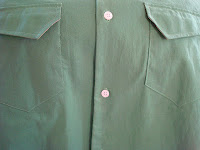 |
| Early type Singer seam guide |
 |
| Later type Singer seam guide |
 Both types will screw into either hole in the machine bed of a black Singer sewing machine [say a Singer 66 for instance Matt] I've taken pictures just to prove my point. Notice that the later type can be swivelled about to allow for sewing curved seams.
Both types will screw into either hole in the machine bed of a black Singer sewing machine [say a Singer 66 for instance Matt] I've taken pictures just to prove my point. Notice that the later type can be swivelled about to allow for sewing curved seams.
If you have a zig-zag machine you can also use this type of seam guide to help with making a blind hem. I haven't done it yet myself but this operation is on my experimental to-do list
Now this is not, as you might think, a six inch/15 cm ruler. It is, in point of fact, a knitting and sewing gauge. I know this because it has this written on one end of it. This gadget, with its sliding marker, has a number of uses. I use it a lot to set up the seam guides on my black Singers, none of which have markings on their throat plates.
The next land mark is the mystery hole nestling snugly in the D-shaped throat plate. Don't look for one of these if you have a VS machine like a Singer 28, 27, 128 or 127 because I don't think you will find one. I'm not entirely sure what the intended purpose of this hole is. I think it might be something to do with an under-braiding attachment sold by Singer. The other interesting fact is that by using this hole as a seam guide you will be sewing a ⅝ seam which just so happens to be the industry standard for home sewing patterns. Don't believe me? Check the sewing gauge - handy eh?
 |
| Sewing and knitting guage |
Now although these old Singer are not marked in the way that a modern machine would be there are landmarks if you know how to read them. I've tried to illustrate the first here. This is the front one of the two screws which actually hold the throat plate on to the bed of the machine. Check out the seam gauge. If you use the right edge of this screw as a reference point you'll be sewing a quarter inch seam allowance. This is useful for those who piece quilt tops and other patchwork projects.
Now, without the aid of the seam gauge, if you have the older type of seam guide and thumb screw you have two useful default settings. The first I wrote about last time is for a ⅜ seam allowance and the second is achieved in the following way. Set the thumb screw in the threaded hold nearest the throat plate and position the flat side of the seam guide as close to the thumb screw as possible. This creates a spacing of one inch. I suspect that this might well come in handy for turning hems.
Some people have seam guides and use them, some people have sewn beautifully for decades and have never seen a seam guide never mind used one. They were a standard in the accessory boxes for Singer sewing machines so millions must have been stamped out over the years. Bear this in mind if you are going to buy one. I wouldn't want pay more than a couple of pounds for one. It might be more cost effective to buy a job lot of accessories that include a seam guide - mixed lots turn up regularly on ebay. If you can find one to buy cheaply or, even better, get one given to you you will have an easy to use accessory which will really earn its keep.
In parting I leave you with a link to one of Muv's (of Lizzie Leonard Vintage Sewing fame) excellent video tutorials. If you're not familiar with her videos and blog check them out. They are a priceless source for the care and use of vintage machines! I cannot recommend them enough!



































